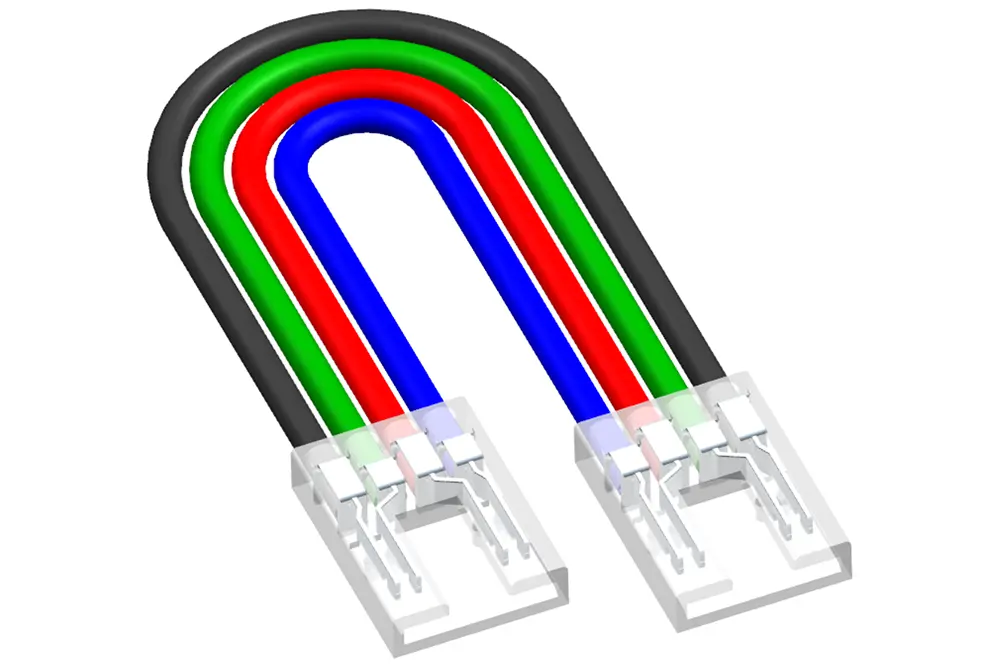Each LED light strip connects in unique ways.
Whether brightening a workspace or setting the mood at home, LED strip connectors ensure steady current flows through the setup, allowing seamless connectivity.
These connectors, integral to LED strip lights, enable users to achieve customized lengths and configurations. By understanding how they work, one can create versatile and dynamic lighting displays.
Let’s explore further.
Introduction to LED Light Strip Connectors
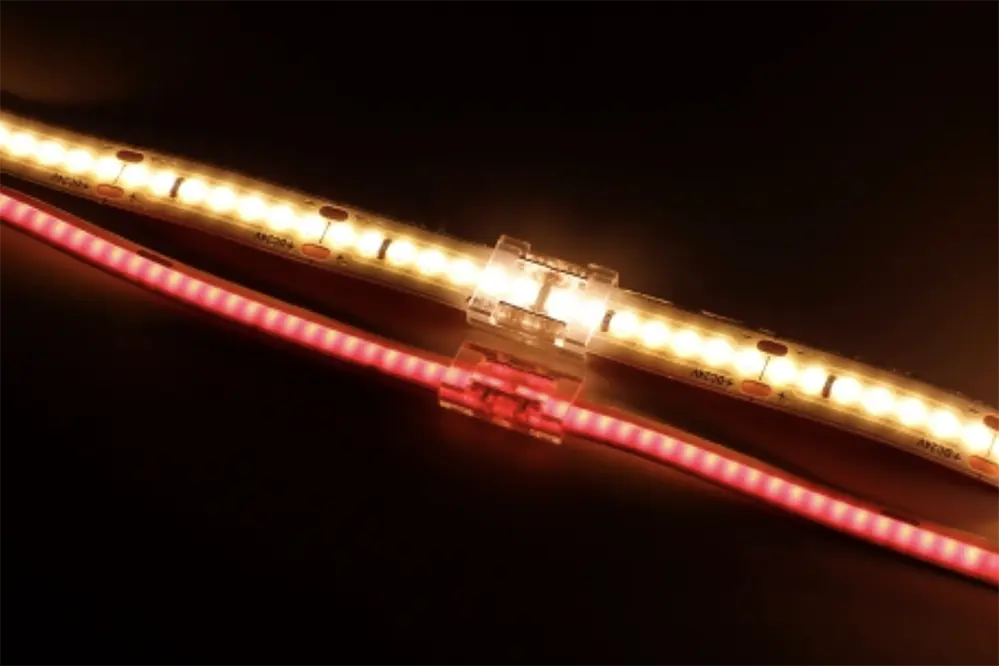
LED light strip connectors are essential components in modern lighting solutions, enabling flexibility, and creativity in installations.
For anyone diving into DIY projects or professional setups, these connectors are vital.
They are designed to offer easy installation and seamless connectivity of LED strips without needing complex wiring.
With a proper understanding of how LED light strip connectors work, one can unlock their full potential to craft bespoke lighting arrangements effortlessly. This knowledge serves as a foundation for innovative designs, fostering an environment of limitless possibilities.
Types of LED Light Strip Connectors
When delving into the realm of LED light strip connectors, various choices emerge, each tailored to specific needs and applications.
Firstly, there are pin connectors, which provide straightforward connectivity.
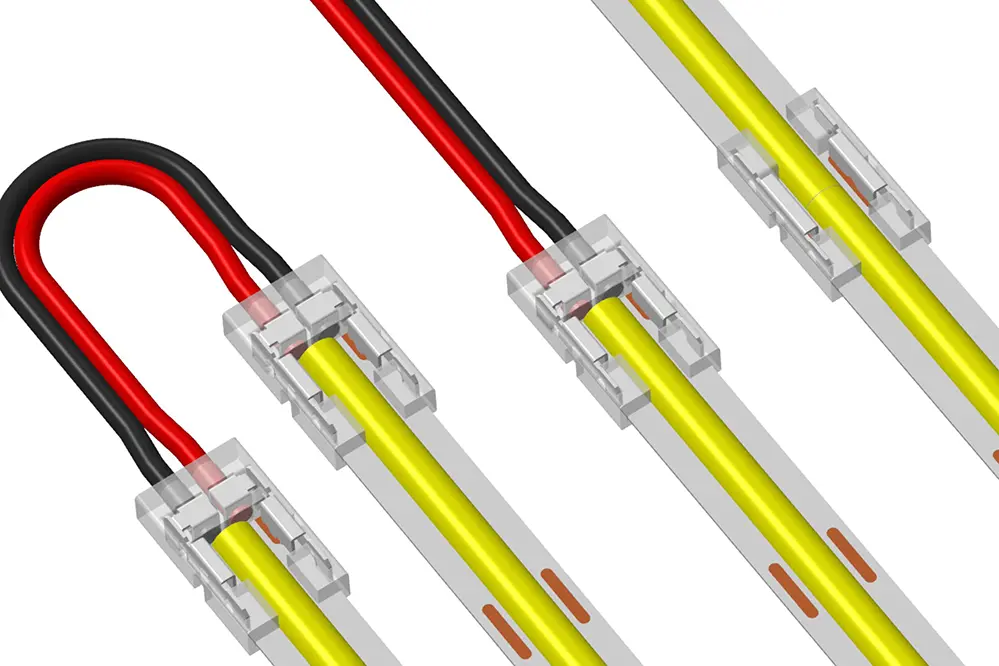
These connectors are ideal for monochromatic LED strips, ensuring consistent current flow.
Moreover, snap connectors offer a tool-free solution, often used for RGB systems, simplifying installation without soldering.
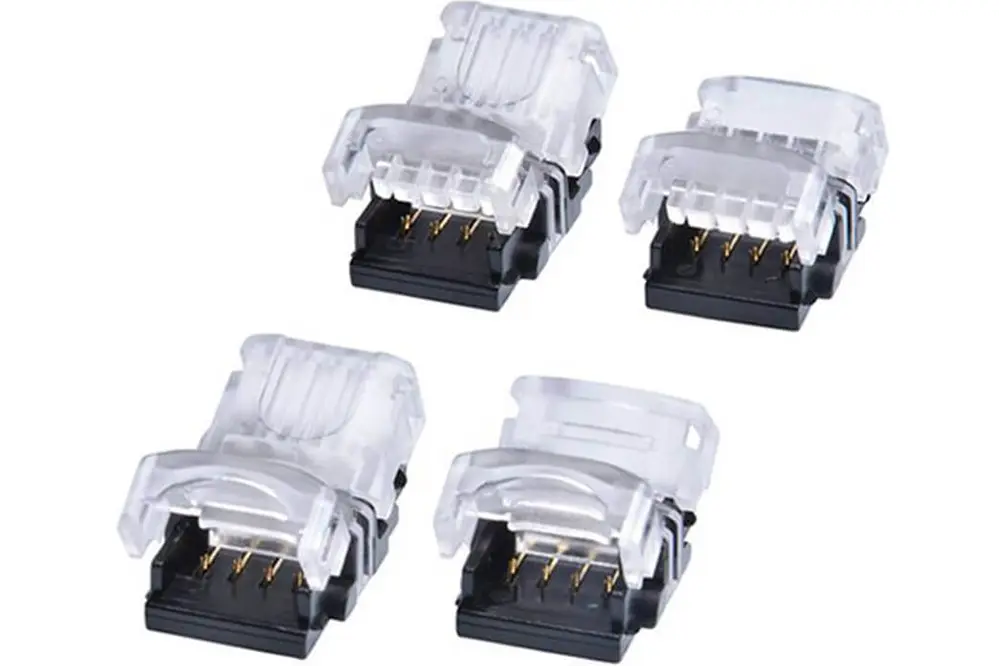
Angle connectors are useful for navigating tight spaces and enabling precise corner turns.
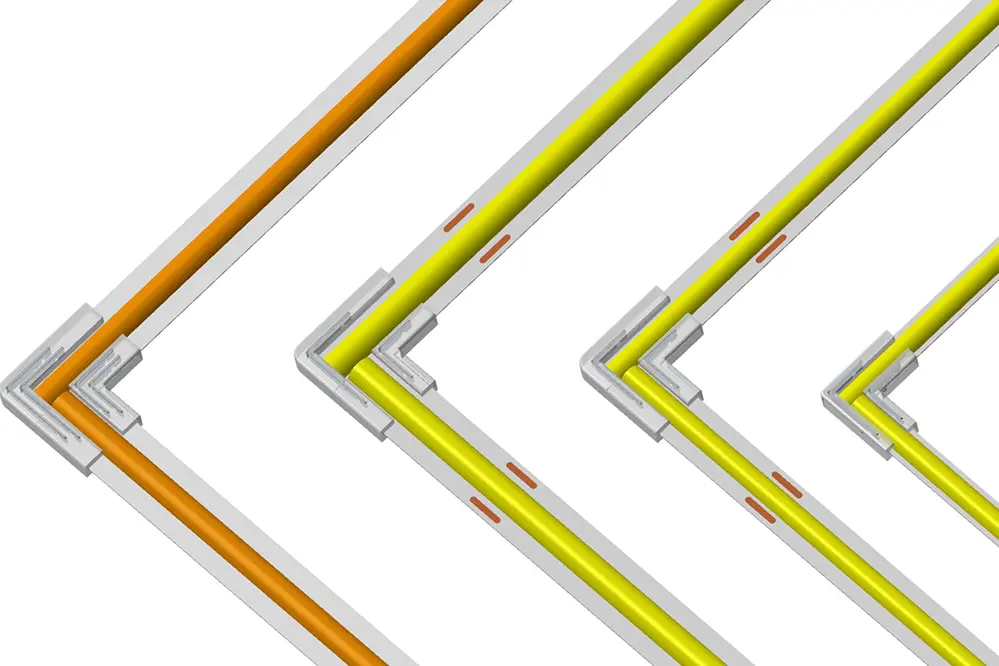
Last but not least, solderless connectors stand out for their robust and reliable connections, perfect for intricate setups requiring durability.
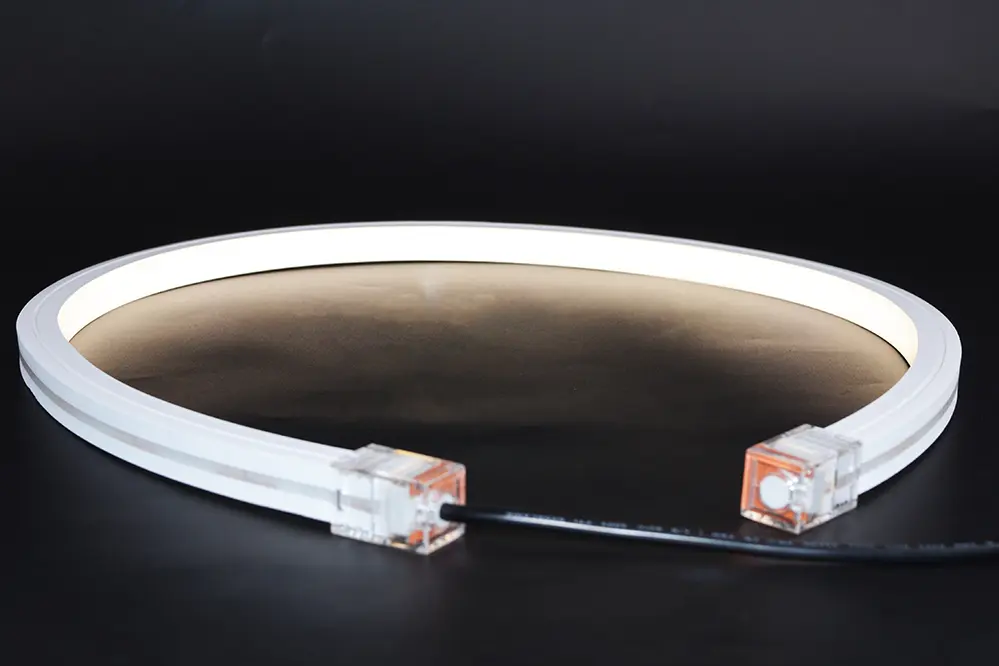
How Do LED Light Strip Connectors Work?
LED light strip connectors function as essential intermediaries between separate segments of LED strips, enabling seamless transmission of power and signals.
These connectors ensure the proper flow of electricity required for illumination.
They consist of metal pins or conductive pads which align accurately with the contact points on the LED strips, ensuring correct polarity. This precise alignment is crucial for maintaining consistent lighting performance.
Professionals often utilize these connectors to reduce installation time and eliminate the need for complex soldering or understanding a detailed wiring diagram. By leveraging these connectors, they can achieve professional-grade installations with efficiency and ease, thereby opening up a world of creative lighting opportunities.
Components of LED Light Strip Connectors
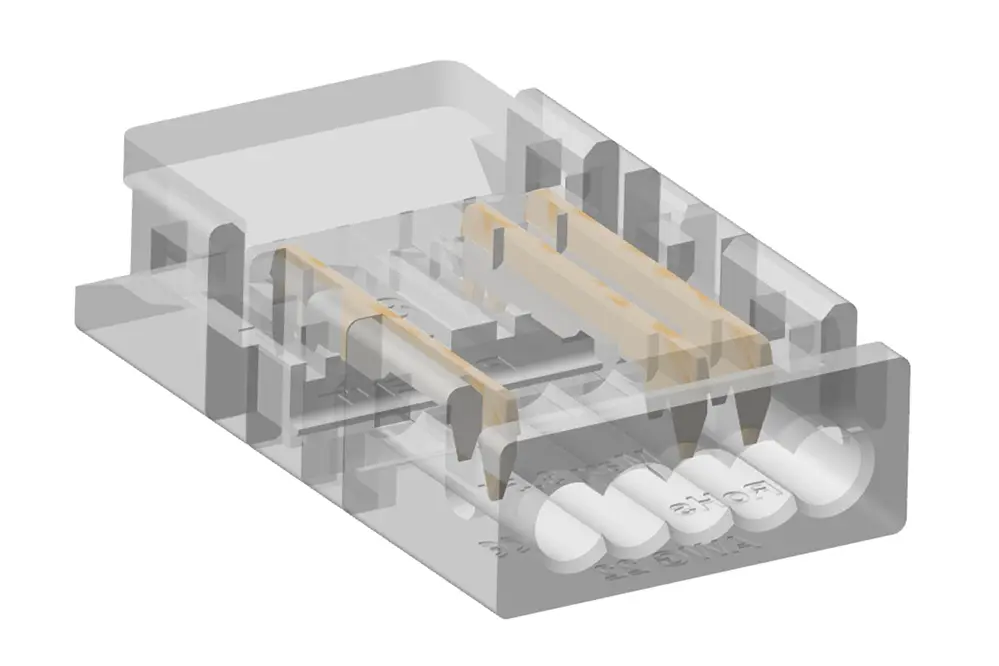
LED light strip connectors are composed of several key elements, ensuring their functionality and reliability in various setups.
The primary component, often a plastic or metal casing, houses the internal contacts. These internal contacts, typically made of high-quality conductive material, interface with the LED strip’s contact points to facilitate the transmission of power and data. Additionally, the casing protects these delicate contacts from environmental factors, ensuring longevity and performance.
Furthermore, many connectors include locking mechanisms for security. By securing the LED strip firmly within the connector, these mechanisms prevent any inadvertent disconnections, which can be particularly beneficial for installations where stability is paramount, such as in commercial settings or dynamic environments.
Lastly, some advanced connectors feature integrated circuit components to regulate voltage or support wireless control. These integrated circuits not only enhance the connector’s functionality but also contribute to the overall efficiency and versatility of LED lighting systems, empowering users to create innovative and dynamic lighting solutions with confidence.
Single-Color vs. RGB LED Connectors
Single-color LED connectors, as the name implies, are designed solely for LED strips emitting a single color. These connectors are typically simpler in construction, having only two contact points: positive and negative.
They mainly serve applications where the user desires a straightforward and consistent light display. Despite their simplicity, these connectors are efficient and reliable.
RGB LED connectors, on the other hand, bring more versatility. They include multiple contact points (typically four) to accommodate the additional color channels.
This configuration allows users to create dynamic and vibrant light displays, making them ideal for projects requiring customizable lighting effects. RGB connectors enable the control of red, green, and blue LEDs individually, resulting in a wide spectrum of colors.
For both single-color and RGB connectors, ease of installation is a shared advantage, minimizing setup time and effort. Their design compatibility with various LED strips ensures that users, regardless of their project’s complexity, can find connectors that meet their needs.
Ultimately, the choice between single-color and RGB connectors depends on the intended application. Knowing how each type of connector works can greatly enhance project outcomes.
Choosing the Right Connector for Your LED Strip
Selecting the appropriate connector significantly influences the success of an LED lighting project.
Recent years, advancements in connector technology have addressed scenarios where users may need quick and secure connections for their LED installations.
First, it’s crucial to recognize that different connectors cater to distinct LED strip types, such as single-color, RGB, and RGBW strips. Evaluating these options can lead to better connectivity and performance.
Secondly, the installation environment should guide the choice. For instance, outdoors might require weatherproof connectors, while indoor settings benefit from sleek, easily concealable connectors.
Careful consideration ensures optimal performance and minimizes potential issues in LED lighting projects.
Common Connector Configurations
Common connector configurations vary based on the requirements of the specific LED strip project.
Recent years, innovative designs have streamlined installation, catering to both novice and expert users with varying needs.
Typically, one will find connectors that fit single-color LED strips alongside those designed for RGB or RGBW strips. Tailoring these configurations ensures a perfect fit and better conductivity.
These configurations often include pin connectors, clamps, or solderless setups, each catering to diverse application scenarios. Selecting the right type benefits the project immensely.
LED connector configurations are crucial for efficient installations, optimizing both time and performance.
Using Quick Connectors for Easy Installation
Quick connectors simplify the installation process tremendously.
These connectors often come with a push-down mechanism that secures the LED strip. This hassle-free system allows for rapid and secure connections, reducing the time and effort required for setup. Consequently, users can ensure the longevity of their connections without the tedious task of soldering.
They greatly benefit both novices and experts.
Quick connectors eliminate the guesswork, offering a foolproof method to achieve a perfect connection. Whether a novice just starting or an expert seeking efficiency – these connectors deliver time-saving solutions right out of the box.
Thus, quick connectors are an excellent choice for any project.
Their innovative design ensures steadfast connections, guaranteeing that users experience uninterrupted illumination. This reliable performance, coupled with their ease of use, makes quick connectors indispensable for modern LED installations.
How to Securely Attach Connectors to LED Strips
Securing connectors to LED strips requires careful precision.
Firstly, ensure the LED strip’s surface is clean and free from debris. Any foreign material on the strip can impede the connection, causing potential malfunctions. Next, slide the connector gently onto the strip, making sure the pins align perfectly with the copper pads. Misalignment can lead to poor connectivity or damage to the strip.
Avoid touching the LED strip contacts.
Use tools such as tweezers to position the connector accurately. This avoids any oils or contaminants from your fingers interfering with the connection.
Finally, once aligned, apply gentle but firm pressure to secure the clip into place. They should hear a click indicating a proper connection.
Consistent and meticulous handling ensures a robust connection, maximizing both performance and lifespan of their LED installations. This meticulous adherence to securing connectors effectively safeguards against intermittent connections, ensuring constant and reliable illumination.
Troubleshooting Common Connector Issues
Even with meticulous handling, issues may arise, necessitating some troubleshooting to maintain optimal functionality.
For instance, if they encounter flickering lights or sections failing to illuminate, checking the alignment and securing of the connectors is crucial. Oftentimes, the pins may not be in full contact with the copper pads, thus disrupting the circuit. Re-securing the connectors to ensure proper alignment is often the solution to this problem.
Additionally, there might be a loose fit or a compromised clip. In such cases, a gentle tightening can resolve the connectivity issues. If the problem persists, inspecting for any signs of wear or damage on the connectors and replacing them might be necessary to restore full functionality.
Checking for proper voltage is another essential troubleshooting step. Different LED strips have varying voltage requirements, and an incorrect power supply can lead to subpar performance. Ensuring the power source matches the LED strip’s requirements can resolve many inconsistent lighting issues, providing a stable and enduring illumination.
Benefits of Using LED Light Strip Connectors
Increased adaptability for diverse installations.
LED light strip connectors provide ease of use and flexibility. They allow individuals to link multiple segments of light strips seamlessly, making it an ideal solution for expansive or intricate projects. Consequently, these connectors offer significant customization options, enabling users to align their light strips precisely to their desired design.
Enhanced safety and reliability.
Quality connectors ensure a secure and reliable connection, minimizing the risks of short circuits. Their robust construction translates to fewer interruptions in lighting, leading to an enhanced user experience and reduced maintenance requirements over time.
Time-saving and cost-effective installation.
Using LED light strip connectors dramatically reduces the complexity of setting up lighting systems. Instead of soldering wires, which is time-consuming and requires specialized skills, connectors simplify the process and make it more accessible even to those with limited electrical understanding.
The aesthetic appeal and versatility brought by these connectors can also not be overlooked. They enable the creation of sophisticated and visually complex lighting arrays that add charm and functionality to residential and commercial spaces alike. Investing in high-quality LED light strip connectors is, therefore, a prudent decision for anyone looking to elevate their lighting solutions efficiently and effectively.
DIY LED Strip Projects with Connectors
Creating DIY LED strip projects with connectors opens a realm of possibilities for enthusiasts. They can transform mundane spaces into vibrant, modern environments with ease and precision.
Connectors facilitate secure and straightforward installations, enhancing project workflows.
These projects are inherently flexible, allowing individuals to manipulate intricate designs without extensive technical knowledge. This accessibility turns ambitious lighting concepts into achievable realities, fostering creativity.
Moreover, LED strip connectors empower designers to tailor lighting designs to their specific needs. They can effortlessly adapt to varying lengths or configurations by leveraging the versatility of connectors, making it possible to undertake both small and large-scale projects with equal confidence. As a result, DIY LED strip projects become not only feasible but highly rewarding endeavors.
Safety Tips for Connecting LED Strips
Always prioritize safety before beginning your project.
Ensuring secure connections will not only prevent electrical hazards but also extend the life of your LED strips. It’s crucial to switch off power sources prior to any installation activities, thereby mitigating any risk of electric shocks. Furthermore, verify that all connectors are rated for the LED strip’s voltage to maintain consistent performance.
Avoid overloading the circuit.
Consider using proper tools – a sharp pair of scissors for cutting, and ensuring ends are clean – to achieve reliable, effective connections.
Taking appropriate measures ensures seamless installations and long-lasting results, contributing significantly to the success of your LED strip project. Lastly, be mindful of adhering to manufacturer guidelines and seeking professional advice if uncertain about any installation steps. With these safety tips in mind, anyone can safely and confidently bring their creative LED visions to life.
Frequently Asked Questions About LED Connectors
How do LED light strip connectors work?
LED light strip connectors play a crucial role in the setup of LED light strips as they ensure secure connections between different segments. These connectors are designed to facilitate the seamless flow of electrical current across the strip, ensuring consistent illumination.
Can I install LED connectors without professional help?
Yes, installing LED connectors can be done without professional assistance, especially if one follows the manufacturer’s guidelines closely. However, for complex projects, seeking expert advice may enhance the longevity and performance of the setup.
Are there different types of LED connectors?
Indeed, there are various types of LED connectors, including clip-on, solder, and screw-on connectors. Each type caters to specific installation needs, providing flexibility in creating bespoke lighting designs.
How do I choose the right connector for my LED strip?
Selecting the appropriate connector depends on several factors, such as the width of the LED strip, the number of contacts, and whether the strip is waterproof. Consulting the LED strip’s specifications will aid in making a well-informed decision.
Do LED connectors affect the brightness of the strip?
No, quality LED connectors should not impact the brightness of the LED strip. Ensuring correct installation augments the overall effectiveness and efficiency of the lighting system.
Innovations in LED Connector Technology
LED connectors have witnessed remarkable advancements, making installations easier, safer, and more efficient. These innovations have significantly transformed the lighting industry, promising a brighter future.
Newer connectors provide better compatibility with a wider range of LED strips, enhancing versatility in applications.
Furthermore, contemporary designs include improved heat dissipation mechanisms, extending the lifespan of connected LED strips.
Manufacturers have also integrated smart functionalities into connectors, enabling remote control and automation of lighting systems, adding a modern touch to traditional setups.
Connectors with advanced sealing technologies offer robust protection against moisture and dust, making them suitable for both indoor and outdoor applications.
Overall, the rapid progression in LED connector technology instills confidence in users, ensuring that their lighting installations are both cutting-edge and reliable.
Final Thoughts on LED Light Strip Connectors
LED light strip connectors are a crucial innovation in modern lighting, simplifying installations and enhancing efficiency. They ensure precise and secure connections, promoting innovation and sophistication in lighting projects. Embracing these connectors highlights a commitment to advanced technology, sustainability, flexibility, and smart functionalities, ensuring a bright and efficient future.
For those seeking to elevate their lighting projects with the latest in LED technology, partnering with a reputable manufacturer is essential. Unitop, a professional Chinese manufacturer of LED strip lights and LED neon strips together with all types of connectors, offers unparalleled expertise and quality. Our commitment to innovation and excellence ensures that every product meets the highest standards of performance and reliability. By choosing Unitop, individuals and businesses can confidently transform their lighting visions into reality, leveraging the best in modern illumination solutions.
